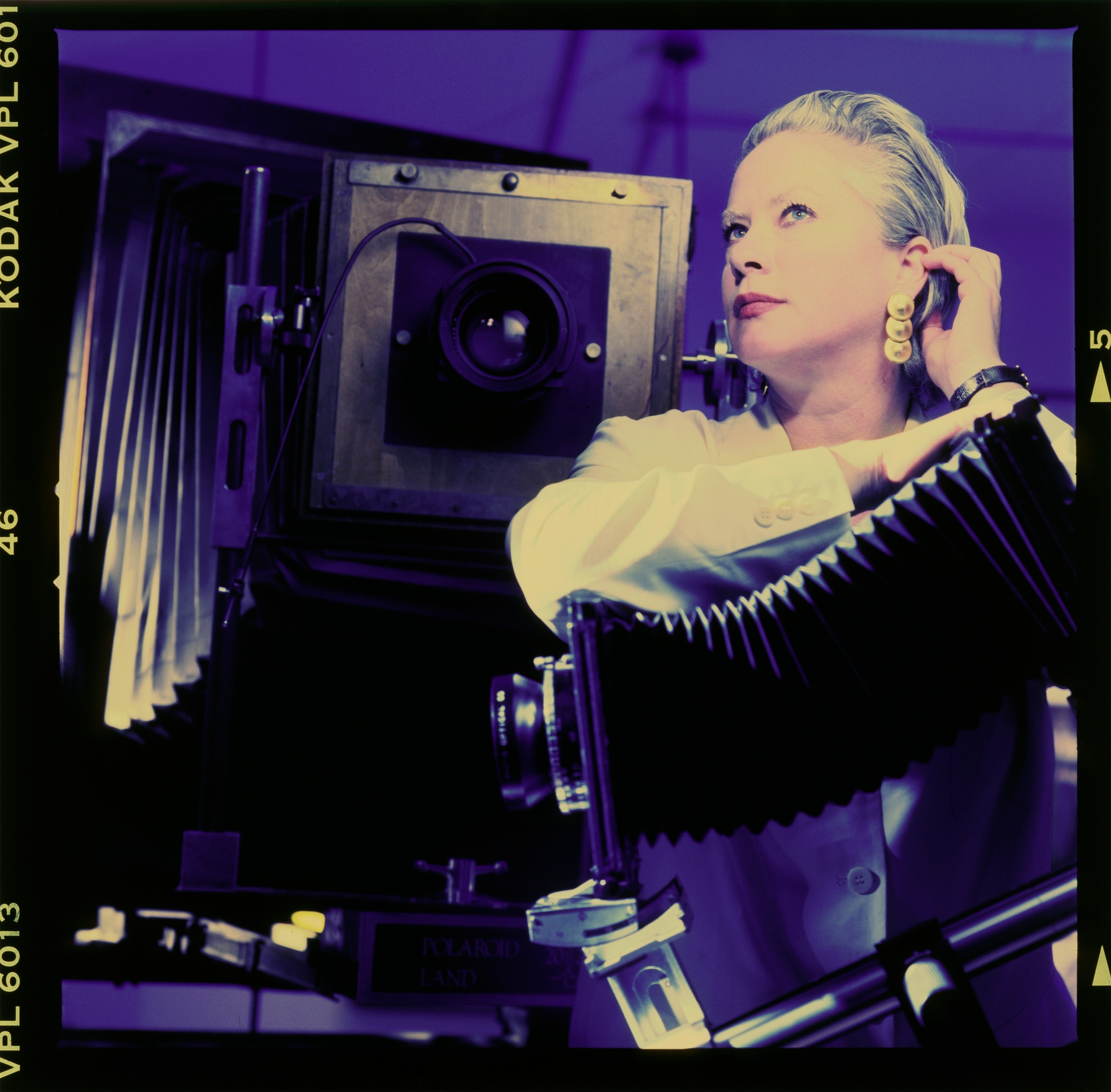Ellen Carey in the Polaroid 20 x 24 Studio, NYC
By Douglas Levere
––
Ellen Carey:
Artist Statement
Abstraction in photography and lens-based art presents an anomaly of sorts. Well developed in the 20th century in other areas —Abstract Expressionism, Minimalism and Conceptual Art — it is still emergent at the close of the first decade of the 21st century. It is here, in the relatively early stages of modern and contemporary art, sharing their roots as they do in photography, that my work has a context. I am fully aware that these developments are largely based in America, as I go about embodying tenets of this legacy in my art. The American invention of Polaroid 20 X 24 camera/film expanded breakthroughs in visual thinking, contributing to my discovery of the Pull in 1996 in which I produced an abstract/minimal image that was simultaneously a photograph and a process befitting my umbrella concept Photography Degree Zero. My other artistic practice and concept, Struck by Light, parallels yet another legacy — a process from the dawn of photography (1834) — that of the photogram method discovered by the British inventor William Henry Fox Talbot (1800 – 1877).
Aspects of my artworks reference this rich history, being conceptually linked and informed as they are through such visual characteristics as the shadow and silhouette image seen in the object as a negative. Formal issues of size and scale, in tandem with palette, create visual impact. The content-laden aspects of my work weigh in — their echo embedded and realized in my choices of method and material — acknowledging that these contain symbols and signs, thereby creating and adding to my art’s meaning. Themes such as mourning, love and loss are seen in muted, monochrome tones, often expressed as site-specific minimal, monumental, gridded tableaux. Black, white and grey have aesthetic as well as conceptual value and are underscored in the content behind my pictures, giving them a context. This reductive palette can highlight line and shape when the ubiquitous codes of the circle (the camera’s lens) and square (the camera’s body) are also used. Stark and subtle, these three are colors, serving as a reference to drawing with light, a historical phrase that points to the medium’s origins in the 19th century.
In parallel with this is my work that emphasizes color — that it has purpose and exists for a reason. Joyful feelings of creativity reflect a discipline where I am digging deeper into color’s mother lode, revisiting terms, such as color processing, in new and experimental ways. Color is subject and object, material with meaning, process within the art. Again, this gives my work context in the relatively young field of color photography, itself just over a century old. Color is a universal language, as are art, photography, and music. The end results are innovative and challenging artworks known for their rich synoptic clarity — with well thought-out conceptual underpinnings that expand content in the realms of art and photography by introducing new forms, such as the conical loop. I discovered this form, known as the parabola, in my Pulls. It can also be seen in a color’s shadow as revealed in my photograms entitled Push Pins. Feeling and form are juxtaposed, seen in unprecedented and unpredictable ways, and expressed through methods and techniques which I have mastered and further developed from within an array of unusual and striking combinations that in themselves heralded an ensuing, new nomenclature.
My tools of choice for creative expression include the 20th century large-format Polaroid 20 X 24 camera, one of five in the world. It has both been used by myself for close to three decades and has become synonymous with contemporary art. My second tool is known as the photogram, an antiquated cameraless process which dates from photography’s emergence in the 19th century. As one would use tubes of paint, I use light, in all its forms, as a common denominator. This interdisciplinary approach reflects my creative endeavors and artistic interests in a medium well known and highly regarded for its technical advances over a span of more than two centuries. My approach, which enriches the visual arts and broadens the parameters of our picture culture, composes with film/enlarger/camera (or cameraless) in tandem with my experiments, inventions, and applications within a variety of processes/methods/techniques. A new interest of mine, the biology of seeing, brings my work into the 21st century. Herein I initiate use of a third tool, digital imaging technologies, appreciative of the medium’s ability to introduce scale, a much-needed formal issue in my work. Its ability to expand an existing palette’s range, through contrast and saturation, is leading to new possibilities; its capacity to reverse and/or manipulate an image presents even richer ones.
As a metaphor for the field and myself as the art maker, I begin with 19th century black and white, often using the photogram, enter the 20th century through color and Polaroid, and reach the 21st century through digitalization. These three methods, en masse with my color photogram, create one huge, ink-jet print. My new interest in the biology of seeing is the unifying concept perfectly realized in a monumental, digital image that was exhibited with individual photograms and also installed as six gigantic, unique color photograms (R/G/B/Y/M/C), entitled Blinks. This idea has tremendous flexibility and could transfer into other forms and disciplines, such as painting, sculpture, and printmaking, or as site-specific, time-based installations, and a myriad of projects as they develop. My artistic education and background are reflected in the ways I move freely among other contemporary art practices while exploring and embracing my cultural and creative interests.

